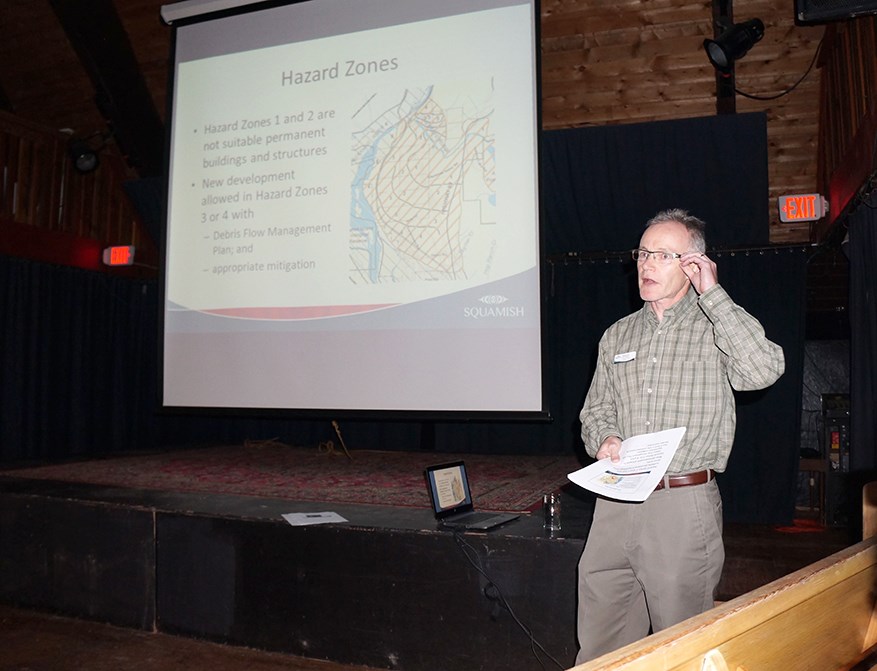Protecting the lives of those who live – or may come to live – on the Cheekye Fan in northern Brackendale is complex and will be costly. Those were two of the main messages of District of Squamish’s public information meeting Sept. 2.
About 20 people were on hand at the Brackendale Art Gallery for the district’s first of three information meetings, titled “How Safe is Safe Enough? Managing Debris Flow Risks on the Cheekye Fan.”
In March, council directed district staff to look into a range of options to reduce the risk for those living on the fan, to come up with costs and funding ideas for those mitigation options, and to engage the public about tolerable risk and mitigation options.
The district is just starting to look at mitigation strategies, said Gary Buxton, general manager of development services and public works.
The next step is modelling those options and costing them out.
For years it has been known there is too high a risk for those living on the Cheekye Fan and that something has to be done, but what to do has been the sticking point.
The issue was brought to the forefront for the district about two and a half years ago with the submission of a community plan amendment by Cornerstone Developments Ltd. (of which the Squamish Nation is a partner), which is proposing a 750-unit residential complex that crosses hazard areas 3 and 4 on the fan.
In October, there will be public consultation for the rezoning application for the development, Buxton said.
“That is being undertaken with the assumption that mitigation can be done,” he said. “We are sort of saying, ‘When we get to the point of mitigation, what kind of zoning would the community like to see?’”
But Buxton stressed the hazard on the fan existed long before the development’s submission.
“This has just really prompted the conversation, it is not the source of the issue, and regardless of whether or not this proceeds, the issues around hazard and risk we are going to have to address.”
Squamish’s Official Community Plan currently states high up on the fan, thus into the most hazardous zones (Zones 1 and 2), is unsuitable for human residence; the lower zones closer to the Squamish River (Zones 3 and 4) have the potential for development, as long as a debris flow management plan is put in place.
One of the options for mitigation the district is considering is a massive debris flow barrier Cornerstone would build as part of its development.
The district has hired an engineer to look at alternatives, Buxton said.
“Barriers, deflection berms… and in some cases, there’s possible relocation,” he said. “There may be some areas that cannot be mitigated. We don’t know that yet, but that is one of the options that we are considering.”
“It is not a simple problem, and it doesn’t have a simple solution,” he said.
Buxton said it is too early in the process to assign costs to mitigation options, even for the barrier proposed by Cornerstone.
“Bottom line, whatever mitigation we choose, there are going to be construction and maintenance costs [for the district],” he said. “It is not going to be cheap.”
The provincial and federal governments have so far said they won’t fund the mitigation, Buxton said.
“They may come to the table,” Buxton said. “They have indicated they don’t really want to get into that because we are not the only community in the province that has the same issue.”
The Cheekye Fan is the most studied fan in Canada, according to Buxton.
Studies relating to hazard and mitigation of the fan have been done since the 1940s.
Two expert panels have reported to District of Squamish council on the risks to life for those living on the Cheekye Fan. The first panel in 2014 found that there is the potential of a landslide from Mount Garibaldi of 5.5 million cubic metres of debris – or roughly two times the volume of BC Place Stadium – once every 10,000 years.
The second expert panel recommended the district adopt the Hong Kong landslide risk tolerance criteria: individual yearly risk of dying within the danger area should be less than one-in-10,000 chance for existing development – or the same risk as to a person who skis 100 hours a year – and less than one-in-100,000 for new development.
“We are planning around an extremely unlikely event, because the impact of that is quite substantial,” Buxton said.
Once a mitigation strategy is chosen it will go through a third party review and be sent to council and the provincial government for approvals.
Buxton said it is possible the chosen mitigation could be built within five years.
The next public information sessions will be held on Sept. 16 and 30 at the Brackendale Art Gallery from 7:30 to 9 p.m.



